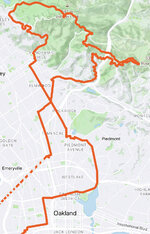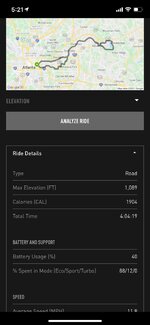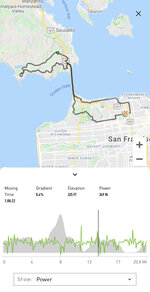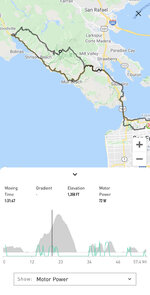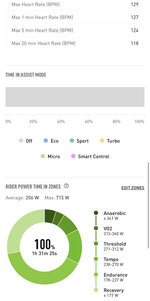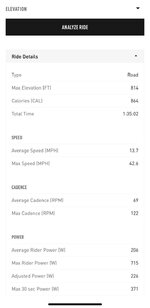Stefan,
I think you are absolutely correct. The Range Calculator probably needs another one or two data fields for age and general physical condition. I started this thread because of my initial disappointment with my battery results on my first challenging ride up Mt. Diablo. After reading all of the following posts, I actually feel very good about the bike and the battery--they are both just fine, but I need improvement!!

I think the Range Extender will be a great help for me.
Yesterday I did a ride in the Berkeley, CA hills that included an "infamous" climb. It's a road in Tilden Park called South Park Drive. Here's a description:
"South Park Dr gains 730′ in 1.4 miles up to Grizzly Peak Blvd; it’s a steep stair step climb! The first section begins with grades of 6-8%, at Big Springs the road tilts up a bit more with grades of 10-14%. It eases up for a short stretch around Laurel and jumps back up again to 11-13% grades around Owl. The road continues with steeper grades of 13-15% all the way up to the gate at Grizzly Peak. The climb up this quiet road with minimal traffic is a slug fest!"
My whole ride was 9 miles, 54 minutes, 1,269' elevation gained, 167.00wh consumption, 221.84% support level. Of course I was at 100% for most of South Park Drive, and in the lowest gear. What I learned from this ride is that I can do
almost any climb on this bike, and that's good news to me. My previous bike with the huge battery and the Bafang BBS02 motor made a climb like this look easy. While I was working my tail off doing this on the Vado, I was pleased that I could do it at all, given how much less power it has compared to the Bafang. Bottom line: I love my new Vado SL 5.0!
By the way, I tried Stefan's Mission Control Profile--35/70, 70/85, 100/100--and it worked very well. With that Sport setting I rarely needed Turbo (except S Park Drive, of course).
I really appreciate all of the feedback you guys offered me here. Thank you.
John
